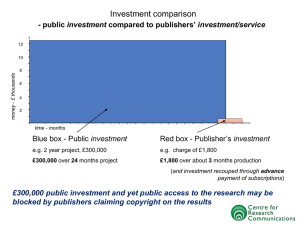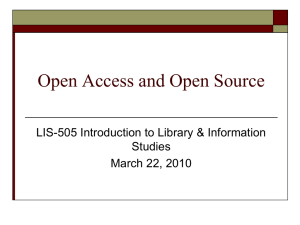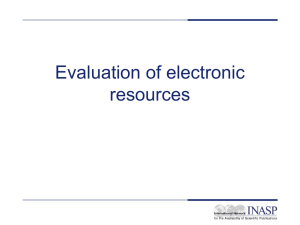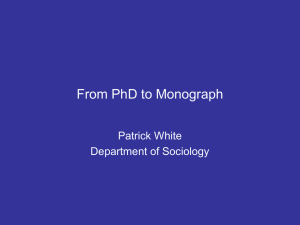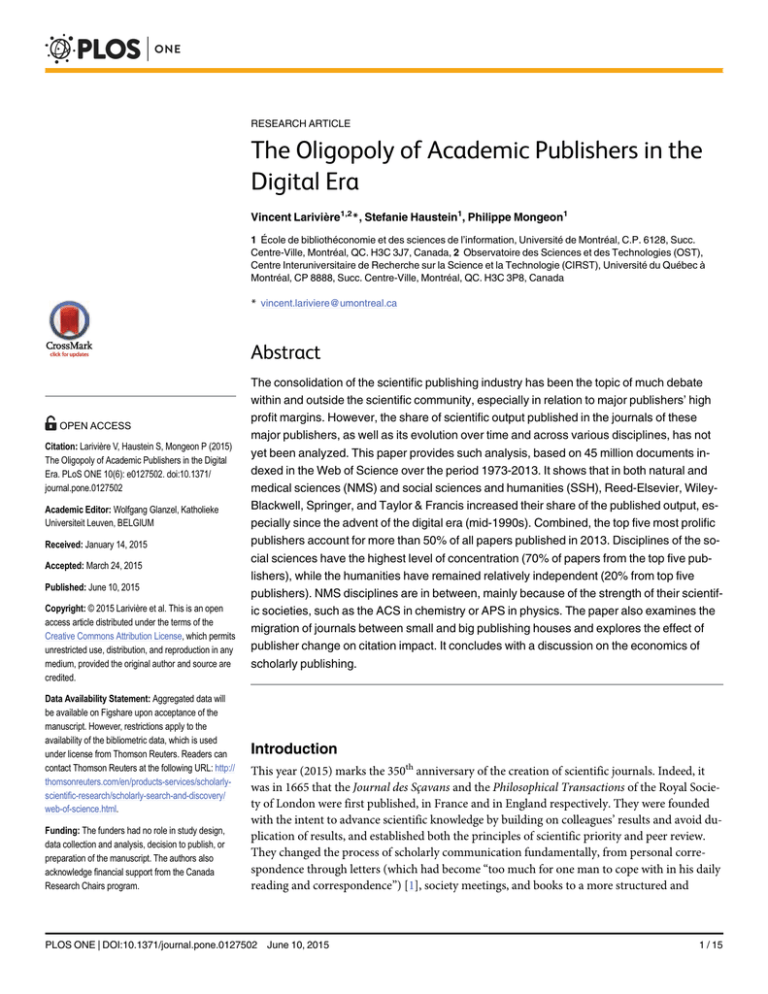
RESEARCH ARTICLE
The Oligopoly of Academic Publishers in the
Digital Era
Vincent Larivière1,2*, Stefanie Haustein1, Philippe Mongeon1
1 École de bibliothéconomie et des sciences de l’information, Université de Montréal, C.P. 6128, Succ.
Centre-Ville, Montréal, QC. H3C 3J7, Canada, 2 Observatoire des Sciences et des Technologies (OST),
Centre Interuniversitaire de Recherche sur la Science et la Technologie (CIRST), Université du Québec à
Montréal, CP 8888, Succ. Centre-Ville, Montréal, QC. H3C 3P8, Canada
* vincent.lariviere@umontreal.ca
a11111
Abstract
OPEN ACCESS
Citation: Larivière V, Haustein S, Mongeon P (2015)
The Oligopoly of Academic Publishers in the Digital
Era. PLoS ONE 10(6): e0127502. doi:10.1371/
journal.pone.0127502
Academic Editor: Wolfgang Glanzel, Katholieke
Universiteit Leuven, BELGIUM
Received: January 14, 2015
Accepted: March 24, 2015
Published: June 10, 2015
Copyright: © 2015 Larivière et al. This is an open
access article distributed under the terms of the
Creative Commons Attribution License, which permits
unrestricted use, distribution, and reproduction in any
medium, provided the original author and source are
credited.
Data Availability Statement: Aggregated data will
be available on Figshare upon acceptance of the
manuscript. However, restrictions apply to the
availability of the bibliometric data, which is used
under license from Thomson Reuters. Readers can
contact Thomson Reuters at the following URL: http://
thomsonreuters.com/en/products-services/scholarlyscientific-research/scholarly-search-and-discovery/
web-of-science.html.
Funding: The funders had no role in study design,
data collection and analysis, decision to publish, or
preparation of the manuscript. The authors also
acknowledge financial support from the Canada
Research Chairs program.
The consolidation of the scientific publishing industry has been the topic of much debate
within and outside the scientific community, especially in relation to major publishers’ high
profit margins. However, the share of scientific output published in the journals of these
major publishers, as well as its evolution over time and across various disciplines, has not
yet been analyzed. This paper provides such analysis, based on 45 million documents indexed in the Web of Science over the period 1973-2013. It shows that in both natural and
medical sciences (NMS) and social sciences and humanities (SSH), Reed-Elsevier, WileyBlackwell, Springer, and Taylor & Francis increased their share of the published output, especially since the advent of the digital era (mid-1990s). Combined, the top five most prolific
publishers account for more than 50% of all papers published in 2013. Disciplines of the social sciences have the highest level of concentration (70% of papers from the top five publishers), while the humanities have remained relatively independent (20% from top five
publishers). NMS disciplines are in between, mainly because of the strength of their scientific societies, such as the ACS in chemistry or APS in physics. The paper also examines the
migration of journals between small and big publishing houses and explores the effect of
publisher change on citation impact. It concludes with a discussion on the economics of
scholarly publishing.
Introduction
This year (2015) marks the 350th anniversary of the creation of scientific journals. Indeed, it
was in 1665 that the Journal des Sçavans and the Philosophical Transactions of the Royal Society of London were first published, in France and in England respectively. They were founded
with the intent to advance scientific knowledge by building on colleagues’ results and avoid duplication of results, and established both the principles of scientific priority and peer review.
They changed the process of scholarly communication fundamentally, from personal correspondence through letters (which had become “too much for one man to cope with in his daily
reading and correspondence”) [1], society meetings, and books to a more structured and
PLOS ONE | DOI:10.1371/journal.pone.0127502 June 10, 2015
1 / 15
The Oligopoly of Publishers
Competing Interests: The authors have declared
that no competing interests exist.
regular distribution of scientific advancements. This structured form, combined with a regular
and wide dissemination, enabled systematic recording and archiving of scientific knowledge
[1–4].
Since the 17th century, the importance of journals for diffusing the results of scientific research has increased considerably. After coexisting alongside correspondence, monographs
and treaties—which often took several years to be published—they became, at the beginning of
the 19th century, the fastest and most convenient way of disseminating new research results [5–
7] and their number grew exponentially [1,8]. During the 20th century they consolidated their
position as the main media for diffusing research [6], especially in the natural and medical sciences [9]. Scholarly journals also contributed to the professionalization of scientific activities
by delimiting the frontier between popular science and the research front and, as a consequence, increased the level of specialization of research and the formation of disciplines. Interestingly, while the majority of periodicals emerged from scientific societies, a significant
proportion were published by commercial ventures as early as in the Victorian era. At that
time, these commercial publishing houses proved more efficient in diffusing them than scientific societies [10]. However, prior to World War II, most scholarly journals were still published
by scientific societies [11]. Data from the mid-1990s by Tenopir and King [12] suggests an increase of commercial publishers’ share of the output; by then, commercial publishers accounted for 40% of the journal output, while scientific/professional societies accounted for 25%
and university presses and educational publishers for 16%. Along these lines, the UK Competition Commission measured various publishers’ shares of ISI-indexed papers for the 1994–1998
period and showed that, over this period, Elsevier accounted for 20% of all papers published
[13]. One could expect, however, that these numbers have changed during the shift from print
to electronic publishing. Indeed, many authors have discussed the various transformations of
the scholarly communication landscape brought by the digital era (see, among others, Borgman [14–15]; Kling and Callahan [16]; Tenopir & King [17]; Odlyzko [18]). However, although the digital format improved access, searchability and navigation within and between
journal articles, the form of the scholarly journal was not changed by the digital revolution
[16,19]. The PDF became the established format of electronic journal articles, mimicking the
print format [20]. What was affected by the digital revolution is the economic aspect of academic publishing and the journal market.
The literature from the late 1990s suggests that the digital era could have had two opposite
effects on the publishing industry. As stated by Mackenzie Owen [21], while some authors saw
the Web as a potential solution to the serials’ crisis—decreasing library budgets facing large
and constant annual increases of journal subscription rates [22,23]—most authors hypothesized that it would actually make the situation worse [24] or, at least, not provide a solution
[25,26]. Despite the fact that it is generally believed that the digitalization of knowledge diffusion has led to a higher concentration of scientific literature in the hands of a few major players,
no study has analyzed the evolution over time of these major publishers’ share of the scientific
output in the various disciplines. This paper aims at providing such analysis, based on all journals indexed in the Web of Science over the 1973–2013 period.
Methods
This paper uses Thomson Reuters’ Web of Science (WoS)—including the Science Citation
Index Expanded, the Social Sciences Citation Index and the Arts and Humanities Citation
Index—transformed into a relational database optimized for bibliometric analysis. On the
whole, 44,483,425 documents are analyzed for the 1973–2013 period, which include all document types published by various journals. In addition to indexing authors’ names, addresses and
PLOS ONE | DOI:10.1371/journal.pone.0127502 June 10, 2015
2 / 15
The Oligopoly of Publishers
cited references, which are the units of analysis typically used in bibliometric studies, the WoS
indexes the name, city and country of the publisher of the journal for each issue. Using this information, which changes over time, we are thus able to assign journals and papers to a publisher and see the evolution of journal ownership. One limitation of this source of data is that it does
not index all of the world’s scientific periodicals but only those indexed in the WoS, which meet
certain quality criteria such as peer review and which are the most cited in their respective disciplines. Hence, this analysis is not based on the entire scientific publication ecosystem but, rather,
on the subset of periodicals that are most cited and most visible internationally.
The journal publishing market is a complex and dynamic system, with journals changing
publishing houses and publishing houses acquiring or merging with competitors. Although
these changes should be reflected in the publisher information provided for each issue, in some
cases, the name of the publisher does not change immediately after a merger or an acquisition.
Publishers’ activities are often distributed among multiple companies under their control, and
over the past 40 years, there have been many mergers and acquisitions involving entire companies or parts of them. We looked at the mergers and acquisitions history of major publishers,
based on their number of papers published, in order to identify and associate the companies
that came to be under their control, and conversely the companies which they eventually sold.
These publishers are the American Chemical Society, American Institute of Physics, American
Physical Society, Cambridge University Press, Emerald, IEEE, Institute of Physics, Karger, Nature Publishing Group, Optical Society of America, Oxford University Press, Reed-Elsevier,
Royal Society of Chemistry, Sage Publications, Springer, Taylor & Francis, Thieme Publishing
Group, Wiley-Blackwell, and Wolters Kluwer. For example, Reed-Elsevier bought Pergamon
Press in 1991 but, in the WoS, journals remain associated with Pergamon Press until the year
2000. Hence, we assigned any journal published by Pergamon Press since 1991 to Reed-Elsevier.
In the case of partial acquisitions, journals were assigned to the publisher only if at least 51% of
the company was under its control. Historical merger and acquisition data up to 2006 was
found in the report by Munroe [27]. The data for subsequent years was retrieved from the companies’ profiles in the Lexis Nexis database, as well as in the press releases found on publishers’
websites.
Results
Fig 1A presents, for Natural and Medical Sciences (NMS) and Social Sciences and Humanities
(NMS), the proportion of papers published by the top five publishers that account for the largest number of papers in 2013, as well as the proportion of papers published in journals others
than those of the top five publishers. Fig 1B provide numbers for the proportion of journals
published by various publishers, while Fig 1C presents the publishers’ share of citation received. What is striking for both domains is the drop, since the advent of the digital era in the
in the mid-1990s, in the proportion of papers, journals and citations that are published/received by journals from publishers other than the five major publishers. In both NMS and SSH,
Reed-Elsevier, Wiley-Blackwell, Springer, and Taylor & Francis are amongst the top five publishers with the highest number of scientific documents in 2013. While in NMS the American
Chemical Society makes it to the top five (in fourth place in 2013), the fifth most prolific publisher in the SSH is Sage Publications. Hence, while all top publishers in SSH are private firms,
one of the top publishers in NMS is a scientific society.
In terms of numbers of papers published, the five major publishers in NMS, accounted, in
1973, for little more than 20% of all papers published. This share increased to 30% in 1996, and
to 50% in 2006, the level at which it remained until 2013 when it increased again to 53%. In
this domain, three publishers account for more than 47% of all papers in 2013: Reed-Elsevier
PLOS ONE | DOI:10.1371/journal.pone.0127502 June 10, 2015
3 / 15
The Oligopoly of Publishers
Fig 1. Percentage of Natural and Medical Sciences (left panel) and Social Sciences and Humanities
(right panel) papers published by the top 5 publishers, 1973–2013.
doi:10.1371/journal.pone.0127502.g001
PLOS ONE | DOI:10.1371/journal.pone.0127502 June 10, 2015
4 / 15
The Oligopoly of Publishers
(24.1%; 1.5 fold increase since 1990), Springer (11.9%; 2.9 fold increase), and Wiley-Blackwell
(11.3%; 2.2 fold increase). The American Chemical Society (3.4%; 5% decrease) and Taylor &
Francis (2.9%; 4.9 fold increase) only account for a small proportion of papers. In the SSH, the
concentration increased even more dramatically. Between 1973 and 1990, the five most prolific
publishers combined accounted for less than 10% of the published output of the domain, with
their share slightly increasing over the period. By the mid-1990s, their share grew to collectively
account for 15% of papers. However, since then, this share has increased to more than 51%,
meaning that, in 2013, the majority of SSH papers are published by journals that belong to five
commercial publishers. Specifically, in 2013, Elsevier accounts for 16.4% of all SSH papers (4.4
fold increase since 1990), Taylor & Francis for 12.4% (16 fold increase), Wiley-Blackwell for
12.1% (3.8 fold increase), Springer for 7.1% (21.3 fold increase), and Sage Publications for 6.4%
(4 fold increase). On the whole, for these two broad domains of scholarly knowledge, five publishers account for more than half of today’s published journal output. Very similar trends are
observed for journals and citations, although with a less pronounced concentration, especially
for citations in NMS which have remained quite stable between 1973 and the late 1990s. For instance, while the top 5 publishers account for 53% (NMS) and 51% (SSH) of papers, their proportion of journals is of 53% (NMS) and 54% (SSH), and of 55% (NMS) and 54% (SSH) when
it comes to citations received. This suggests that the top 5 publishers publish a higher number
of papers per journal than other publishers not making the top five, and that their papers obtain, on average, a lower scientific impact.
The increase in the top publishers’ share of scientific output has two main causes: 1) the creation of new journals and 2) existing journals being acquired by these publishers. Fig 2
Fig 2. Number of journals changing from small to big publishers, and big to small publishers per year of change in the Natural and Medical
Sciences and Social Sciences & Humanities.
doi:10.1371/journal.pone.0127502.g002
PLOS ONE | DOI:10.1371/journal.pone.0127502 June 10, 2015
5 / 15
The Oligopoly of Publishers
presents, for both NMS and SSH, the number of journals over time that changed ownership
from small to big publishers—that is, the four publishers with the largest share of published papers in both NMS and SSH—and, for NMS, the number of journals that moved from big to
small publishing houses. Since we intend to emphasize developments of the publishing market
by publisher type and not single actors, changes among small as well as among big publishers
are not shown. It can be seen in both domains that, before 1997, publisher type changes were
overall quite rare and the majority consisted of changes from big to small publishers in NMS.
Importantly, not a single journal was found to have switched from a big to small publisher in
SSH during the entire period of analysis. A first important large wave of journal acquisitions by
the big publishers occurred in 1997–1998, when Taylor & Francis acquired several journals
from Gordon & Breach Science Publishers, Harwood Academic Publishers, Scandinavian University Press, Carfax Publishing and Routledge. In the same period Reed-Elsevier acquired a
few small publishers like Butterworth-Heinemann, Ablex Publications, JAI press, GauthierVillars and Expansion Scientifique Française. The next important peak occurred in 2001, and
is mainly due to Reed-Elsevier continuing a series of acquisitions, including Academic Press,
Churchill Livingstone, Mosby and WB Saunders. Finally, the peak of 2004 is mainly due to the
acquisition of Kluwer Academic Publishers by Springer, who had not previously been involved
in substantial journal acquisition activities. Wiley-Blackwell’s contribution to the four peaks in
Fig 2 was steadier, with the company acquiring an average of 39 journals annually from various
publishers during the 2001–2004 period.
The share of journal papers published by the five publishers differs amongst the various disciplines in NMS and SSH. Figs 3 and 4 present the evolution of the top five publishers’ share of
papers by discipline. Not surprisingly, chemistry has the highest level of concentration, as one
of its disciplinary publishers, the ACS, made it to the top five most prolific publishers of NMS.
For most disciplines, however, concentration in the top five publishers increased from between
10% and 20% in 1973 to between 42% and 57% in 2013, with a clear change of slope in the
mid-1990s. Physics, on the other hand, follows a different pattern: after increasing from 20% in
1973 to 35% in 2000, it has since then remained stable and is subsequently the discipline where
the top five publishers account for the lowest proportion of papers published. This lower concentration of papers in big publishers’ journals is mainly due to the strength and size of physics’
scientific societies, whose journals publish an important proportion of scientific papers in the
field (Fig 5). In 2013 for instance, journals of the American Physical Society (APS) and of the
American Institute of Physics (AIP) each account for 15% of papers, while those of the Institute
of Physics (IOP) represent 8% of papers. It is also worth noting that, in physics, Reed-Elsevier’s
journals’ share of papers also decreased over the last decade or so, from 28% of papers in 2001
to 21% in 2013. Springer, however, increased its percentage of physics papers from 3% to 11%
over the same period. On the whole, the central importance of scientific societies in physics,
the presence of arXiv, the central preprint server of physics, astrophysics and mathematics, as
well as Open Access agreements such as SCOAP3 (http://scoap3.org/), are likely to make the
field less profitable and thus less interesting for commercial publishers. In biomedical research,
the share of the top five publishers almost reached 50% in 2009 (49%), but then decreased to
42% in 2013, mainly as a result of the emergence of new publishers, such as the Public Library
of Science and its mega-journal PLOS ONE, which publishes more than 30,000 papers
per year.
Fig 4 clearly shows that disciplines typically labelled as ‘social sciences’ behave differently
from the arts and humanities. For each discipline within the domain of social sciences (psychology, professional fields, social sciences and social aspects of health), there is an unambiguous change in the slope in the mid-1990s: while the top five—in this case, commercial—
publishers accounted for percentages between 15% and 22% of the output in 1995, these
PLOS ONE | DOI:10.1371/journal.pone.0127502 June 10, 2015
6 / 15
The Oligopoly of Publishers
Fig 3. Percentage of papers published by the five major publishers, by discipline in the Natural and Medical Sciences, 1973–2013.
doi:10.1371/journal.pone.0127502.g003
percentages increased to between 54% and 71% in 2013. The disciplines in social sciences,
which includes specialties such as sociology, economics, anthropology, political sciences and
urban studies, is quite striking: while the top five publishers accounted for 15% of papers in
1995, this value reached 66% in 2013. Combined, the top three commercial publishers alone—
Reed-Elsevier, Taylor & Francis and Wiley-Blackwell—represent almost 50% of all papers in
2013. Psychology follows a similar pattern, with the top five publishers increasing from 17% in
1995 to 71% in 2013.
On the other hand, papers in arts and humanities are still largely dispersed amongst many
smaller publishers, with the top five commercial publishers only accounting for 20% of humanities papers and 10% of arts papers in 2013, despite a small increase since the second half of the
1990s. The relatively low cost of journals in those disciplines—a consequence of their lower
publication density—might explain the lower share of the major commercial publishers. Also,
the transition from print to electronic—a strong argument for journals to convert to commercial publishers—has happened at a much slower pace in those disciplines as the use for recent
scientific information is less pressing [28]. Moreover, these disciplines make a much more important use of books [9] and generally rely on local journals [29], all of which are factors that
make it much less interesting for big publishers to buy journals or found new ones in the arts
and humanities.
PLOS ONE | DOI:10.1371/journal.pone.0127502 June 10, 2015
7 / 15
The Oligopoly of Publishers
Fig 4. Percentage of papers published by the five major publishers, by discipline of Social Sciences and Humanities, 1973–2013.
doi:10.1371/journal.pone.0127502.g004
Fig 5. Percentage of papers published by the five major publishers in Physics, 1973–2013.
doi:10.1371/journal.pone.0127502.g005
PLOS ONE | DOI:10.1371/journal.pone.0127502 June 10, 2015
8 / 15
The Oligopoly of Publishers
Fig 6. Evolution of the mean relative citation impact of papers, by distance to publisher change, 1995–1998 and 2001–2004.
doi:10.1371/journal.pone.0127502.g006
Fig 6 presents the changes in articles’ relative citation rates for journals that have changed
from small to big and big to small publishers (see Fig 1) for the 10 years before and after the
transition. We focus on two four-year periods to ensure comparable environments for the publishing market and selected 1995–1998 and 2001–2004, as they were identified as important
consolidation phases in Fig 1. More specifically, for NMS, those that have changed from small
to big publishers increased their impact slightly following the change. However, while for the
2001–2004 cohort of journals this followed a drop in impact, impact of the 1995–1998 cohort
was relatively stable before. For the journals moving from big to small publishers, there is no effect: impact remains similar prior to and after the change. In SSH, no noticeable effect can be
observed: changing from a small to a big commercial publisher does not affect papers' citation
rates. It is also worth mentioning that, except for journals moving from small to big publishers
between 2001 and 2004, the mean impact of papers before and after remained below the world
average. It suggests that, on average, journals changing publishers did not produce many high
impact papers.
Discussion and Conclusion
The effect of scientific societies
On the whole, our results show that the top commercial publishers have benefited from the digital era, as it led to a dramatic increase in the share of scientific literature they published. It has
also led to a greater dependence by the scientific community on these publishers. Despite the
fact that the two broad domains have both experienced an increase in the concentration of papers in the hands of a few publishers reaching 50% in recent years, a clear distinction was observed between NMS and SSH. In the former group of disciplines, the size of scientific societies
—which is a consequence of the size of disciplines in general—managed to keep the literature
less dependent on commercial publishers. For example, scientific societies such as the ACS or
the APS publish many journals in the specialties of chemistry and physics respectively, for
PLOS ONE | DOI:10.1371/journal.pone.0127502 June 10, 2015
9 / 15
The Oligopoly of Publishers
which they successfully managed the shift from print to electronic. On the other hand, social
sciences are much more fragmented: anthropology, communication, criminology, demography, economics and sociology can all be considered social sciences. Yet, there is no large scientific society that regroups researchers from these disciplines and that also publishes the various
journals covering these different disciplines. There are, rather, many different associations for
each discipline, which are often divided into specialities. Along these lines, topics in SSH are
also more often local in scope—and thus much less international—which also lead to more decentralized—and thus smaller—scientific societies. As a consequence, these scientific societies
did not have the means to adapt to the digital era and therefore were more likely to be acquired
or have agreements with big commercial publishers for the publication of their journals. This is
a clear shift from the traditional model of scholarly communication. As Lyman and Chodorow
[25] put it:
“University presses and disciplinary associations were founded to disseminate research in
the original cycle of scholarly communication. The faculty produced the work to be published; non-profit publishers organized the distribution of knowledge; the university library
bought the published work at an artificially high price, as a subsidy for learned societies; and
the faculty used this literature as the foundation for further research and teaching. [. . .]
However, over the past fifty years, as federal research funding has encouraged specialization,
journal publishing has become commercialized, and some parts of the scientific and technical literature are now being monopolized by multinational publishing conglomerates.”
(p. 89)
The economics of scholarly publishing
As one might expect, the consolidation of the publishing industry led to an increase of the profits of publishers. Fig 7 presents, as an example, the evolution of Reed-Elsevier’s profits over the
1991–2013 period, for the firm taken as a whole as well as for its Scientific, Technical & Medical division. One can clearly see in Fig 7A that, between 1991 and 1997, both the profits and
the profit margin increased steadily for the company as a whole. While profits more than doubled over that period—from 665M USD to 1,451M USD—profit margin also rose from 17% to
26%. Profit margins decreased, however, between 1998 and 2003, although profits remained
relatively stable. Absolute profits as well as the profit margin then rose again, with the exception of the 2008–2009 period of economic crisis, resulting in profits reaching an all-time high
of more than 2 billion USD in 2012 and 2013. The profit margin of the company’s Scientific,
Technical & Medical division is even higher (Fig 7B). Moreover, its profits increased by a factor
of almost 6 throughout the period, and never dropped below 30% from one year to another.
The profit margin of this division never decreased below 30% during the period observed, and
steadily increased from 30.6% to 38.9% between 2006 and 2013. Similarly high profit margins
were obtained in 2012 by Springer Science+Business Media (35.0%, see: http://static.springer.
com/sgw/documents/1412702/application/pdf/Annual_Report_2012_01.pdf), and in 2013 and
John Wiley & Sons’ Scientific, Technical, Medical and Scholarly division (28.3%, see: http://
www.wiley.com/legacy/about/corpnews/fy13_10kFINAL.pdf) and Taylor and Francis (35.7%,
see: http://www.informa.com/Documents/Investor%20Relations/Annual%20Report%202013/
Informa%20plc%20Annual%20Report%20Accounts%202013.pdf), putting them on a comparable level with Pfizer (42%), the Industrial & Commercial Bank of China (29%) and far above
Hyundai Motors (10%), which comprise the most profitable drug, bank and auto companies
among the top 10 biggest companies respectively, according to Forbes’ Global 2000 [30]. At a
PLOS ONE | DOI:10.1371/journal.pone.0127502 June 10, 2015
10 / 15
The Oligopoly of Publishers
Fig 7. Operating profits (million USD) and profit margin of Reed-Elsevier as a whole (A) and of its Scientific, Technical & Medical division (B),
1991–2013. Compilation by the authors based on the annual reports of Reed-Elsevier. (http://www.reedelsevier.com/investorcentre/pages/home.aspx)
Numbers for the Scientific, Technical & Medical division were only available in GBP; conversion to USD was performed using historical conversion rates from
http://www.oanda.com.
doi:10.1371/journal.pone.0127502.g007
total revenue of 9.4 billion US dollars in 2011 [31], the majority of which were generated by a
few publishing houses, the scientific journal publishing market faces oligopolistic conditions,
where big players such as Elsevier, Springer, Taylor & Francis, Wiley-Blackwell and Wolters
Kluwer determine annually increasing subscription rates that make up a considerable amount
of research spending, leaving academic libraries with no other choice but to cancel subscriptions [20,32,33].
The possibility to increase profits in such an extreme fashion lies in the peculiarity of the
economics of scholarly publishing. Unlike usual suppliers, authors provide their goods without
financial compensation and consumers (i.e. readers) are isolated from the purchase. Because
purchase and use are not directly linked, price fluctuations do not influence demand. Academic
libraries, contributing 68% to 75% of journal publishing revenues [31], are atypical buyers because their purchases are mainly controlled by budgets. Regardless of their information needs,
they have to manage with less as prices increase. Due to the publisher’s oligopoly, libraries are
more or less helpless, for in scholarly publishing each product represents a unique value and
cannot be replaced [19,20,33,34].
Scholarly publications themselves can be considered information goods with high fixed and
low variable costs [35,36]. Regarding academic journals, fixed or first-copy costs comprise
manuscript preparation, selection and reviewing as well as copy-editing and layout, writing of
editorials, marketing, and salaries and rent, the two most substantial of which, manuscript
writing and reviewing, are provided free of charge by the scholarly community [20]. In that
sense and contrary to any other business, academic journals are an atypical information good,
because publishers neither pay the provider of the primary good—authors of scholarly papers
PLOS ONE | DOI:10.1371/journal.pone.0127502 June 10, 2015
11 / 15
The Oligopoly of Publishers
—nor for the quality control—peer review. On the publisher’s side, average first-copy costs of
journal papers are estimated to range between 20 and 40 US dollars per page, depending on rejection rates [37]; [17], which neither explains open access publication fees as high as 5,000
$US (e.g., Cell Reports by Elsevier) nor hybrid journals, where publishers charge twice per article, i.e. the subscription and open access fees (e.g., Open Choice by Springer or Online Open by
Sage Publications).
In addition, the Ingelfinger law, initiated by the publisher of the New England Journal of
Medicine in 1969, prohibits authors from submitting their manuscript to more than one journal [38]. Although the law was initially created to protect the journal’s revenue streams and has
become largely obsolete through electronic publishing [39], it is still a universal rule in academic journal publishing, often enforced by copyright transfer agreements. Hence, each journal has
the monopoly on the scientific content of papers it publishes: paper A published in journal Y is
not an alternative to paper B published in journal Z [11]. In other words, access to paper A
does not replace access to paper B, both papers being complementary to each other.
Variable costs of academic journals are paid by the publisher and, as long as journals were
printed and distributed physically, these costs were sizeable. In the print era, publishers had to
typeset the manuscripts, print copies of journals, and send them to various subscribers. Hence,
each time an issue was printed, sent and sold, another copy had to be printed to be sent and
sold. However, with the advent of electronic publishing, these costs became marginal. The digital era exacerbated this trend and increased the potential revenues of publishers. While, in economic terms, printed journals can be considered as rival goods—goods that cannot be owned
simultaneously by two individuals—online journals are non-rival goods [40]: a single journal
issue that has been uploaded by the publisher on the journal’s website can be accessed by many
researchers from many universities at the same time. The publisher does not have to upload or
produce an additional copy each time a paper is accessed on the server as it can be duplicated
ad infinitum, which in turn reduces the marginal cost of additional subscriptions to 0. In a system where the marginal cost of goods reaches 0, their cost becomes arbitrary and depends
merely on how badly they are needed, as well as by the purchasing power of those who need
them. In addition, costs are strongly influenced by the power relations between the buyer and
seller, i.e. publishers and academic libraries. In such a system, any price is good for the seller, as
the additional unit sold is pure profit. All these factors explain the different and often irrational
big deals made between publishers and subscribers, with university libraries subscribing to a
publisher’s entire set or large bundle of journals regardless of their specific needs [41]. Through
these big deals, university researchers have been accustomed to, for almost 20 years, having access to an increasingly large proportion of the scientific literature published, which makes it
very difficult for university libraries today to cancel subscriptions and negotiate out of big deals
with publishers to optimize their collections and meet budget restrictions.
General conclusions
Since the creation of scientific journals 350 years ago, large commercial publishing houses have
increased their control of the science system. The proportion of the scientific output published
in journals under their ownership has risen steadily over the past 40 years, and even more so
since the advent of the digital era. The value added, however, has not followed a similar trend.
While one could argue that their role of typesetting, printing, and diffusion were central in the
print world [20,7], the ease with which these function can be fulfilled—or are no longer necessary—in the electronic world makes one wonder: what do we need publishers for? What is it
that they provide that is so essential to the scientific community that we collectively agree to devote an increasingly large proportion of our universities budgets to them? Of course, most
PLOS ONE | DOI:10.1371/journal.pone.0127502 June 10, 2015
12 / 15
The Oligopoly of Publishers
journals rely on publishers’ systems to handle and review the manuscripts; however, while
these systems facilitate the process, it is the researchers as part of the scientific community who
perform peer review. Hence, this essential step of quality control is not a value added by the
publishers but by the scientific community itself.
Thus, it is up to the scientific community to change the system in a similar fashion and in
parallel to the open access and open science movements. And, indeed, the scientific community
has started to react to and protest against the exploitative behaviour of the major for-profit
publishers. In 2012, the “Cost of Knowledge” (http://thecostofknowledge.com/) campaign
started by Cambridge mathematician and Fields Medalist Timothy Gowers asked researchers
to protest against Elsevier’s business model through a boycott against its journals by ceasing to
submit to, edit and referee them. Started by a blogpost, the boycott was later termed the beginning of an “Academic Spring” [42,43]. Several university libraries, including large and renowned universities such as the University of California [44] and Harvard [45], stopped
negotiations and threatened to boycott major for-profit publishers, while other universities—
such as the University of Konstanz—simply cancelled all Elsevier subscriptions as they were
neither able nor willing to keep up with their aggressive pricing policy: 30% increase over five
years [46,47].
But these are exceptions. Unfortunately, researchers are still dependent on one essentially
symbolic function of publishers, which is to allocate academic capital, thereby explaining why
the scientific community is so dependent on ‘The Most Profitable Obsolete Technology in History’ [48]. Young researchers need to publish in prestigious journals to gain tenure, while older
researchers need to do the same in order to keep their grants, and, in this environment, publishing in a high impact Elsevier or Springer journal is what ‘counts’. In this general context,
the negative effect of various bibliometric indicators in the evaluation of individual researchers
cannot be understated. The counting of papers indexed by large-scale bibliometric databases—
which mainly cover journals published by commercial publishers, as we have seen in this paper
—creates a strong incentive for researchers to publish in these journals, and thus reinforces the
control of commercial publishers on the scientific community.
Acknowledgments
We would like to thank Sam Work for proofreading and editing the manuscript, as well as the
two referees, for comments and suggestions.
Author Contributions
Conceived and designed the experiments: VL. Performed the experiments: VL SH PM. Analyzed the data: VL SH PM. Wrote the paper: VL SH PM.
References
1.
de Solla Price DJ. Little Science, Big Science. New York: Columbia University Press; 1963.
2.
Haustein S. Multidimensional journal evaluation. Analyzing scientific periodicals beyond the impact factor. Berlin/Boston: De Gruyter Saur; 2012.
3.
Tenopir C, King DW. (2009). The growth of journals publishing. In Cope B, Phillips A, editors. The Future of the Academic Journal. Oxford: Chandos Publishing; 2009. pp. 105–123.
4.
Zuckerman H, Merton RK. Patterns of evaluation in science—institutionalisation, structure and functions of referee systems. Minerva. 1971; 9(1): 66–100.
5.
Harmon JE, Gross AG. The Scientific Literature: A Guided Tour. Chicago: Chicago University Press;
2007.
6.
Meadows AJ. The Scientific Journal. London: Aslib; 1979.
PLOS ONE | DOI:10.1371/journal.pone.0127502 June 10, 2015
13 / 15
The Oligopoly of Publishers
7.
Meadows AJ. Access to the results of scientific research: developments in Victorian Britain. In Meadows AJ, editor. Development of Science Publishing in Europe. Amsterdam: Elsevier Science Publishing; 1980. pp. 43–62.
8.
Meadows AJ. Communication in Science. Butterworths: Seven Oaks; 1974.
9.
Larivière V, Archambault É, Gingras Y, Vignola-Gagné É. The place of serials in referencing practices:
Comparing natural sciences and engineering with social sciences and humanities. Journal of the American Society for Information Science and Technology. 2006; 57(8): 997–1004.
10.
Brock WH. (1980). The Development of Commercial Science Journals in Victorian Britain. In Meadows
AJ, editor. Development of Science Publishing in Europe, Amsterdam: Elsevier Science Publishers;
1980. pp. 95–122.
11.
Kaufman P. (1998). Structure and crisis: Markets and market segmentation in scholarly publishing. In:
Hawkins BL, Battin P, editors. The Mirage of Continuity: Reconfiguring Academic Information Resources for the 21st Century. Washington D.C.: CLIR and AAU; 1998. pp. 178–192.
12.
Tenopir C, King DW. Trends in Scientific Scholarly Journal Publishing in the U.S. Journal of Scholarly
Publishing. 1997; 28(3): 135–170.
13.
Office of Fair Trading. The market for scientific, technical and medical journals. A statement by the
OFT. Report OFT396; 2002. Available: http://www.econ.ucsb.edu/~tedb/Journals/oft396.pdf. Accessed on: 2015 January 5.
14.
Borgman CL. From Gutenberg to the global information infrastructure: Access to information in the networked world. Cambridge, Mass: MIT Press; 2000.
15.
Borgman CL. Scholarship in the Digital Age: Information, Infrastructure, and the Internet. Cambridge,
Mass: MIT Press; 2007.
16.
Kling R, Callahan E. Electronic journals, the Internet, and scholarly communication. Annual Review of
Information Science and Technology. 2003; 37: 127–177. doi: 10.1002/aris.1440370105
17.
Tenopir C, King DW. Towards Electronic Journals: Realities for Scientists, Librarians, and Publishers.
Washington, D. C.: Special Libraries Association; 2000.
18.
Odlyzko AM. Tragic loss or good riddance: The impending demise of traditional scholarly journals. International Journal of Human-Computer Studies. 1995; 42(1): 71–122.
19.
Keller A. Elektronische Zeitschriften. Grundlagen und Perspektiven. Wiesbaden: Harrassowitz Verlag;
2005.
20.
Mierzejewska BI. The Eco-system of Academic Journals. Doctoral dissertation, University of St. Gallen,
Graduate School of Business Administration, Economics, Law and Social Sciences. Bamberg: DifoDruck; 2008.
21.
Mackenzie Owen J. The scientific article in the age of digitization. Dordrecht: Springer; 2007. 22.
22.
Abramson A. Solutions for Delivering Digital Content in the New Academic Enterprise. Library Hi Tech
News. 2000; 17(1).
23.
McGuigan GS, Russell RD. The business of academic publishing: A strategic analysis of the academic
journal publishing industry and its impact on the future of scholarly publishing. Electronic Journal of Academic and Special Librarianship. 2008; 9(3). Available: http://southernlibrarianship.icaap.org/content/
v09n03/mcguigan_g01.html.
24.
Solomon DJ. Talking past each other: making sense of the debate over electronic publication. First
Monday. 2002; 7(8). Available: http://firstmonday.org/ojs/index.php/fm/rt/printerFriendly/978/899.
25.
Lyman P, Chodorow S. (1998) The Future of Scholarly Communication. In Hawkins BL, Battin P, editors. The Mirage of Continuity: Reconfiguring Academic Information Resources for the 21st Century.
Washington D.C.: CLIR and AAU; 1998. pp. 87–104.
26.
Halliday L, Oppenheim C. Developments in digital journals. Journal of Documentation, 2001; 57(2):
260–283.
27.
Munroe, M.H. (2007). The academic publishing industry: a story of merger and acquisition. Available:
http://www.ulib.niu.edu/publishers/
28.
Larivière V, Archambault É, Gingras Y. Long-term variations in the aging of scientific literature: From exponential growth to steady-state science (1900–2004). Journal of the American Society for Information
Science and Technology. 2008; 59(2): 288–296.
29.
Archambault É, Vignola-Gagné É, Côté G, Larivière V, & Gingras Y. Benchmarking scientific output in
the social sciences and humanities: The limits of existing databases. Scientometrics. 2006; 68(3): 329–
342.
30.
Chen L. Best of the biggest: How profitable are the world’s largest companies? Forbes. 13 May 2014.
Available: http://www.forbes.com/sites/liyanchen/2014/05/13/best-of-the-biggest-how-profitable-arethe-worlds-largest-companies/. Accessed 2015 January 5.
PLOS ONE | DOI:10.1371/journal.pone.0127502 June 10, 2015
14 / 15
The Oligopoly of Publishers
31.
Ware M, Mabe M. The STM report. An overview of scientific and scholarly journal publishing. The
Hague: International Association of Scientific, Technical and Medical Publishers; 2012. Available:
http://www.stm-assoc.org/2012_12_11_STM_Report_2012.pdf.
32.
Cope B, Kalantzis M. Signs of epistemic disruption: transformations in the knowledge system of the academic journal. In B Cope, A Phillips, editors. The Future of the Academic Journal. Oxford: Chandos
Publishing; 2009. pp. 11–61.
33.
McCabe MJ. Journal Pricing and Mergers: A Portfolio Approach. American Economic Review. 2002; 92
(1): 259–269.
34.
Meier M. Returning Science to the Scientists. Der Umbruch im STM-Zeitschriftenmarkt unter Einfluss
des Electronic Publishing. München: Peniopel 2002.
35.
Shapiro C, Varian HR. Information Rules. A Strategic Guide to the Network Economy. Boston: Harvard
Business School Press; 1998.
36.
Linde F, Stock WG. Information Markets. A Strategic Guideline for the I-Commerce. Berlin / New York:
De Gruyter Saur; 2011.
37.
Rowland F. The peer-review process. Learned Publishing. 2002; 15(4): 247–258.
38.
Ingelfinger F. Definition of “sole contribution”. New England Journal of Medicine.1969; 281: 676–677.
doi: 10.1056/NEJM196909182811208 PMID: 5807917
39.
Harnad S. (2000). Ingelfinger over-ruled. The Lancet. 2000. doi: 10.1016/S0140- 6736(00)92002-6
40.
Weimer DL, Vining AR. Policy Analysis: Concepts and Practice. Pearson: Prentice Hall; 2011.
41.
Bergstrom TC, Courant PN, McAfee RP, Williams MA. Evaluating big deal journal bundles. Proceedings of the National Academy of Sciences. 2014; 111(26): 9425–9439. doi: 10.1073/pnas.1403006111
PMID: 24979785
42.
Cook G. Why scientists are boycotting a publisher. The Boston Globe. 12 February 2012. Available:
http://www.bostonglobe.com/opinion/2012/02/12/why-scientists-are-boycotting-publisher/
9sCpDEP7BkkX1INfakn3NL/story.html. Accessed 2015 January 5.
43.
Jha A. Academic spring: how an angry maths blog sparked a scientific revolution. The Guardian. 9 April
2012. Available: http://www.theguardian.com/science/2012/apr/09/frustrated-blogpost-boycottscientific-journals. Accessed 2015 January 5.
44.
Howard J. U. of California tries just saying no to rising journal costs. The Chronicle of Higher Education.
8 June 2010. Available: http://chronicle.com/article/U-of-California-Tries-Just/65823/. Accessed 2015
January 5.
45.
Sample I. Harvard University says it can’t afford journal publishers’ prices. The Guardian. 24 April 2012.
Available: http://www.theguardian.com/science/2012/apr/24/harvard-university-journal-publishersprices. Accessed 2015 January 5.
46.
University of Konstanz. More expensive than science allows. Press release No. 28 of 26 March 2014.
Available: http://www.aktuelles.uni-konstanz.de/en/presseinformationen/2014/28/. Accessed 2015
January 5.
47.
Vogel G. German University tells Elsevier ‘no deal’. Science Insider. 27 March 2014. Available: http://
news.sciencemag.org/people-events/2014/03/german-university-tells-elsevier-no-deal. Accessed
2015 January 5.
48.
Schmitt J. Academic journals: The most profitable obsolete technology in history. The Huffington Post
Blog. 23 December 2014. Available: http://www.huffingtonpost.com/jason-schmitt/academic-journalsthe-mos_1_b_6368204.html. Accessed 2015 January 5.
PLOS ONE | DOI:10.1371/journal.pone.0127502 June 10, 2015
15 / 15


